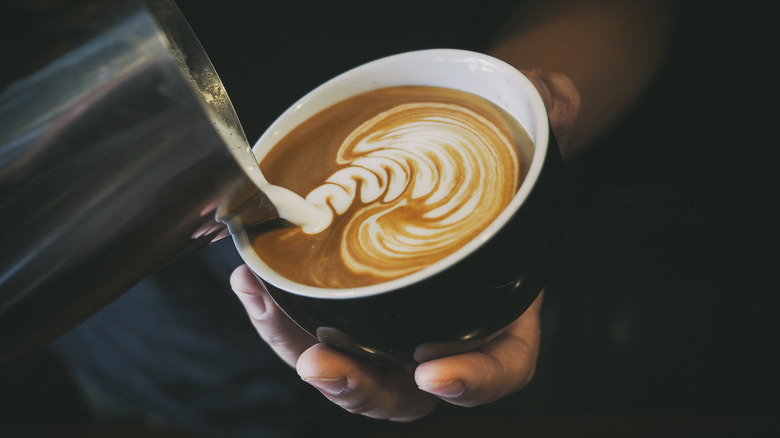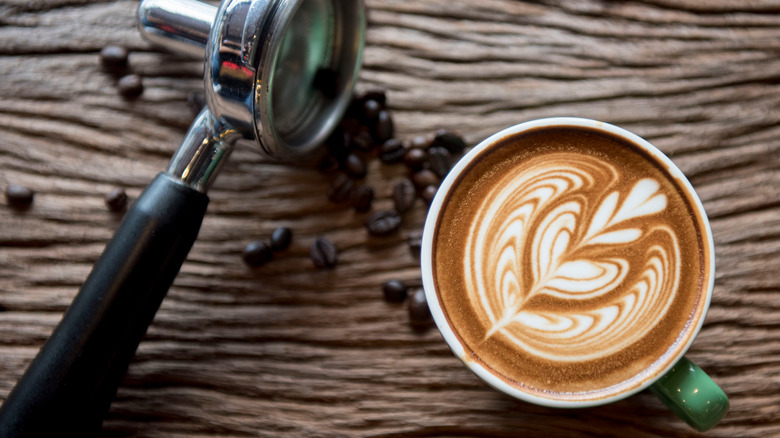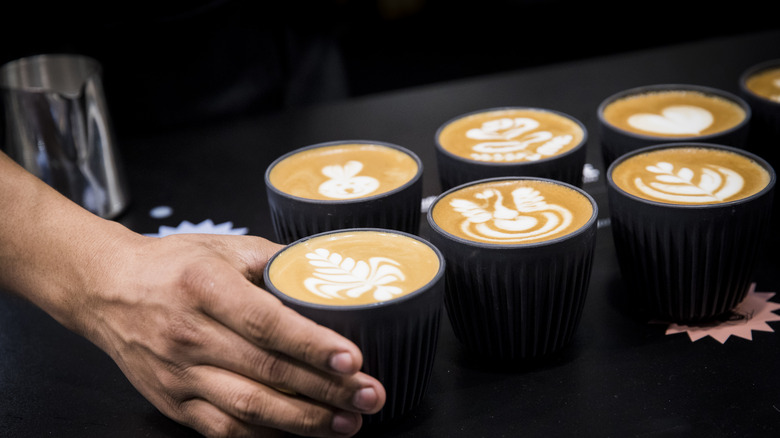The History Of Latte Art Explained
It's almost rare nowadays to order a latte or some other milk-based coffee and have it come out just sort of ... murky, brownish blah? With no creamy milky flower designs on top, or at least the attempt. Sightings have even been reported of intrepid baristas at massive chains like Starbucks getting on board the latte art fun.
When we talk about "latte art," we mean exactly that: transforming the simple act of pouring steamed milk into a cup of espresso into an artistic task. There's a tremendous number of variables involved to make something as commonplace as a tulip-designed latte (one of the most prominent designs) that are better suited for hours of on-the-job training: temperature and type of milk, how to "tamp" down the beans before pulling shots, ristretto (long) vs. espresso (short) shots, thickness and body of the espresso, how darkly the beans were roasted, and so on. Feel free to investigate at your own leisure. You can start with the "Coffee Wheel" on sites like Counterculture Coffee, which shows how to taste coffee the way a sommelier does wine.
Latte art is a by-product of "third wave" coffee (per Driven Coffee Roasters), a global movement toward higher-quality beans and techniques typically found on smaller menus at independent shops. Its history isn't long and vast, and goes back about 30 years to one dude in one shop in Seattle in 1992: coffee lover and Espresso Vivace CEO David Schomer.
Straight from the Seattle coffee scene of the '80s and '90s
Granted, if David Schomer didn't play around with enough coffee and milk to figure out how to make latte art, someone else probably would have. The stage was set in the Pacific Northwest in the late 1980s for a revolution in coffee-making knowledge, technique, and effort that went beyond "put my hot brown liquid in a cup, good sir." As The Coffee Designer says, Schomer got the idea for "texturing" milk from Jack Kelly of Seattle's Uptown Espresso in 1986. If you've ever seen baristas steam milk, then swirl their little milk jug, look into it, and tap, tap it on a surface? That's part of the whole "texturing" thing to produce "microfoam," which makes milk suitable for designs. This isn't possible if coffee shops just sort of blast the temperature of the milk to surface-of-the-sun temperatures.
Schomer perfected the "heart" design in 1989, and "rosetta" in 1992. Along with the "tulip," those are still the three mainstays of latte art, as Wolff Coffee Roasters explains on YouTube. Back in the 1990s, Schomer went on to connect with fellow coffee lover Luigi Lupi in Italy, and they exchanged videos of their designs online. Lupi, who can be seen on YouTube rather casually crafting some artsy lattes start to finish, presented the tulip design at an exhibition as recently as 2004. That's all it took for latte art to blast off around the world.
An evolving art of world championships
Since those not-too-long-ago days, latte art has evolved into a for-real artistic discipline, complete with international competitions such as the World Latte Art Championship, Coffee Fest Latte Art World Championship Open with a bracket-style tournament, and courses around the globe such as Artisan Coffee School in London, Espresso Academy in Florence, or Milk Science & Latte Art certification from Bartisa Hustle, an educational resource that assists over 1 million baristas in 60 countries.
Latte art has really taken off in East and Southeast Asian countries such as Thailand, Hong Kong, South Korea, and more. This is partially because regional bean-growing is often associated with local economies and small-scale farmers getting a viable foothold into a growing industry. U.K. Latte Art champion Dhan Tamang, for instance, grew up in a small village in Nepal with limited access to luxury goods such as coffee, as I'm Not a Barista says. Now, he owns a number of shops around the U.K., and hopes that "coffee can unite a community more than ever." (That's his work, pictured above.)
At this point, latte art includes non-latte drinks like flat whites, piccolos, cortados, and more. As Iorio Gelato summarizes, artists "draw" (pour) and sometimes "etch" (using a thin stick-like tool) their designs. Textured milk mixes with "crema" — a thin layer of foam on the top of espresso — to settle on the surface of the drink and compose the design. Definitely something to appreciate the next time you grab a coffee.


